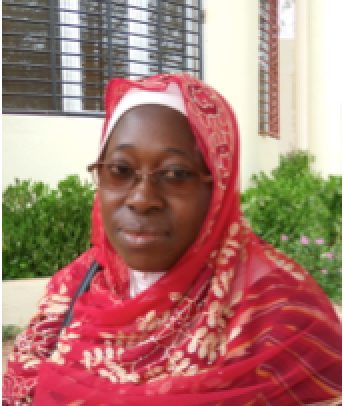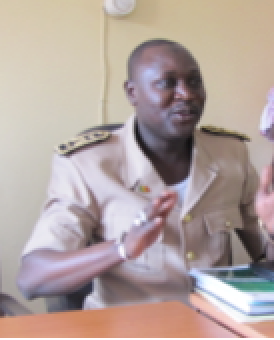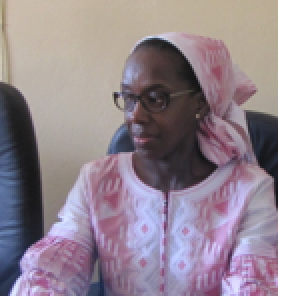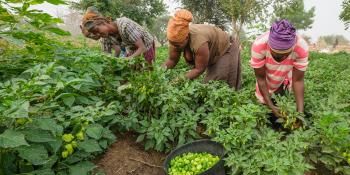Getting farmers ready to understand, receive and use climate information in Senegal

Preparing the readiness of the farmers to understand, receive and effectively use climate information services as an important agricultural input
In Senegal, agriculture employs more than 70% of the labour force and constitutes the backbone of the rural economy. Cereal such as millet, sorghum, maize and rice are grown on more than 60% of the cultivated lands. Smallholder agriculture, which is predominantly rainfed, is already suffering from overexploitation of land, soil degradation and limited use of agricultural inputs. Climate change is magnifying most of these challenges. Rainfall has been inadequate and decreasing in all regions of the country, affecting the food security and livelihood in rural areas.
USAID mission in Senegal is playing a prominent role in improving agricultural productivity in the country through the Feed the Future (FTF) initiative. One approach to building solutions for reducing the adverse effects of the increased climate variability on agricultural productivity, is to provide timely, accurate and appropriate climate and weather information to local decision-makers and agricultural producers. USAID/Senegal has responded to this need by providing supports through the Global Climate Change Fund (GCC) to the CGIAR Research Program on Climate Change Agriculture and Food Security program (CCAFS) which has a long-standing experience in developing and diffusing climate information services (CIS), in order to develop a climate information services provision and diffusion project in Senegal.
The Climate Information Service for Increasing Resilience and Productivity in Senegal project (USAID/CINSERE) aims to build the capacity of relevant organizations such as the Senegalese meteorological service (ANACIM), to succeed in developing and communicating tailored and salient CIS in support of farms’, fisheries’ and pastoralists’ communities in their management decision making for increased resilience and productivity in the FTF projects’ zone of influence (ZOI). Since 2016, USAID/CINSERE in collaboration with ANACIM, different CIS have been produced and diffused at demand in the FTF projects’ ZOI.
To optimize the efficient use of the diffused CIS, ANACIM and USAID/CINSERE project initiated intensive trainings on climate change and on the role of CIS in different localities in Senegal prior to the onset of the 2017 rainy season. These trainings took place from 20 to 22 June 2017.
In order to boost the understanding and uptake of the CIS in the FTF projects’ ZOI in Senegal, ANACIM has planned 26 trainings to take place in different districts prior to the onset of the 2017 rainy season. The planning follows the gradient of the onset of the season. In total, 93 farmers and 34 technicians from the government extension services attended the three trainings. These trainings are crucial in preparing the readiness of the farmers to understand, receive and effectively use the CIS as important agricultural inputs. The trainings occurred in the localities of Kaolack and Nioro from 19 to 23 June while tracking the perceptions of the beneficiaries and partners.
Several diffusing channels developed
For all training sessions, the modules were the same: installation, use and maintenance of manual rain gauges, indigenous rain forecasts, climate change: adaptation and mitigation, scientific seasonal forecast/climate information services and CIS diffusion.
In localities where Naatal Mbay, an USAID project, intervenes, selected farmers are trained to manage rain gauges. This contributes to record downscaled rainfall data in the country, helps producers understand the trend of the local climate and cross-check the recorded data with those from the index insurance companies.
... farmers can no longer accurately forecast a season.
Also, participants were asked to list traditional indicators of seasonal change or forecast. During this exercise, attendees have cited indicators that are related to the direction of the winds, the position or phase of the moon or sun, the appearance of certain plant, fish and insect species, the flowering and/or foliage of certain plant species, the in-migration or out-migration of certain birds, the cries of some birds or insects, etc. Most of these indicators have been affected (extinction, decrease or abundance) by climate change in such a way that farmers can no longer accurately forecast a season. Hence the need to understand climate change and how modern tools are used for weather forecasting with a certain degree of certainty.
ANACIM has produced silent CIS to farmer, fisher and livestock raising communities following the requests from the project’ partners. Some channels such as SMS, voice calls, radios, multidisciplinary working groups for diffusing these CIS have been developed. Participants were trained on how to receive, read and interpret the CIS. To facilitate this, 10 random phone numbers from the participants were recorded to immediately receive warning voice message from the voice messaging platform developed by Jokalante. An hour later, the owners of the selected phone numbers received a voice message in their local language indicating that a rain event will occur during the following day. The message was put in a loud speaker for all attendees to hear the rain forecast. From this message, different decisions could be taken: get prepared to saw after the rain, perform a tillage prior to sawing or to start the dry-sawing prior to the rain.
Next steps
It is expected that the training will reach 1,100 leaders of producers for the year 2017. The trainees are expected in turn to train about 30,000 farmers. USAID/CINSERE in collaboration with the FtF projects will follow-up with the monitoring and evaluation tools developed for the project to ensure the expectations are met.
Participant testimonials

Marie Ndiaye, Specialist of cereal value chain of Naatal Mbay, Kaolack, Kaffrine and Fatick
We appreciate these trainings that came in the right time. The farmers were waiting for this because they heard about CIS but they did not know what it was about. They had a vague idea on climate change but now they fully understand what it is. Producers within our zone of intervention know the utility of the rain gauges. Some of them had received training on the use and maintenance of rain gauges and have been using it for three year. The present training has updated and improved their skills. The link between the indigenous and the science knowledge on rain forecast is well established in the trainings and this comforts local farmers to trust the forecasts they will be receiving. The trainings have been very participative and we really appreciate that. Our strategy is to train the trainers who in turn will train the producers who could be part of the first training. Therefore, we have selected the leaders of the producers to attend this training. Once back home, each leader will transfer the knowledge gained to the rest of his group of producers. The participants have understood that the CI they receive are based on a certain degree of uncertainty and this is very important.”

Mr. Papa Malick Ndao, Prefect of Nioro district
We have received an instruction from our minster and the Governor of the Region of Kaolack to facilitate this training in Nioro. As an actor of development of the district, we are very proud to benefit from the training because we leant from it that climate change seen as a fatality could be an opportunity as well. I thank the experts from ANACIM, USAID the funder of the CINSERE project and CCAFS for their valuable efforts to reduce the negative effects of the climate variability through the CINSERE project. I also thank the farmers and technicians who, despites their busy schedule at the crucial moment, have avail time to attend the training.
I certify that this year, our multidisciplinary working group will be operational. It was formally created last year at the end of the rainy season. This season, I have given instruction for the weekly meetings to take place from the 01 July, whether we have or not financial support. These regular meetings will add important value to the CIS that we will receive from ANACIM."
Dr. Oumou Ly, AOR/CINSERE, USAID Mission in Dakar
The trainings are important and it was so interesting to notice the inclusive participation of the farmers during the trainings. To make it more valuable, I suggest to prepare supporting documents in advance to be shared with the participants. It is also important to reconsider the timing of the trainings. The trainings should occur in a period prior to the onset of the rainy season so that leader participants can have time to share the knowledge they gained with the rest of their producer groups before entering in the farming activities. The MWGs are important tool for CIS diffusion and for appropriate decision making at the district level. Therefore, I think that it should be made operational and sustainable. It is obvious that the government may not be able to financially support all MWGs but I think it is right time that we start exploring for alternative financing sources such as sponsorship from local, national or international institutions."
Further readings
USAID's press release on the official launch of the CINSERE project
Read here the blog on the CINSERE inception workshop
Learn more on the impact of Climate Information services in Senegal in this Case Study
Issa Ouedraogo is the coordinator of the USAID/CINSERE project.
Seynabou Diouf is the Monitoring and Evaluation manager of the USAID/CINSERE project.



